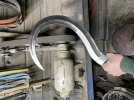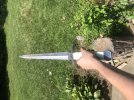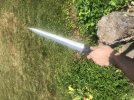Joshua gave some good tips. I have made a katana, a viking sword, a waki, a few tanto, and several daggers.
The easiest sword length piece by stock removal is the katana. This is assuming that your blade profile is a simple convex right to the mune (ridged spine).
To answer your question, I don't run the grinder differently, but remove most of the material with a fresh 36 grit ceramic belt. I mostly use the platen, not the wheel.
A traditional style katana has no plunge and so the grinding is easy, running back and forth, long passes right over where the handle will be, slower to build up heat.
There are other challenges later like fitting a habaki etc, but the actual grind is easiest.
You can stop grinding when you have gone as far as you dare without screwing up and then finish by hand.
The less skill you have or more cautious you are will mean more work by hand (I often leave quite a bit to do by hand).
More difficult is having a long bevel that doesn't reach the spine, and keeping the height even.
For daggers, Joshua mentions either putting in the distal taper first, or achieving it by iteratively over grinding and evening out the center line.
This is not an either/or choice in my experience. Unless your taper and profile match perfectly, even with the taper put in first, you might have sections that take some finesse to bring the ridge together and you will likely do some refining of the center in any case. I do prefer to put in most of the taper in advance. It is easy to mark the blade at intervals and run it under a wheel to hit the desired taper values.
Good luck and post some pictures.




